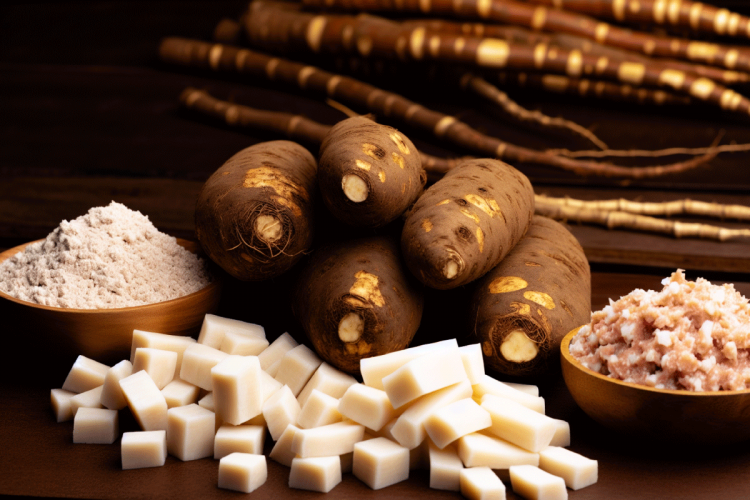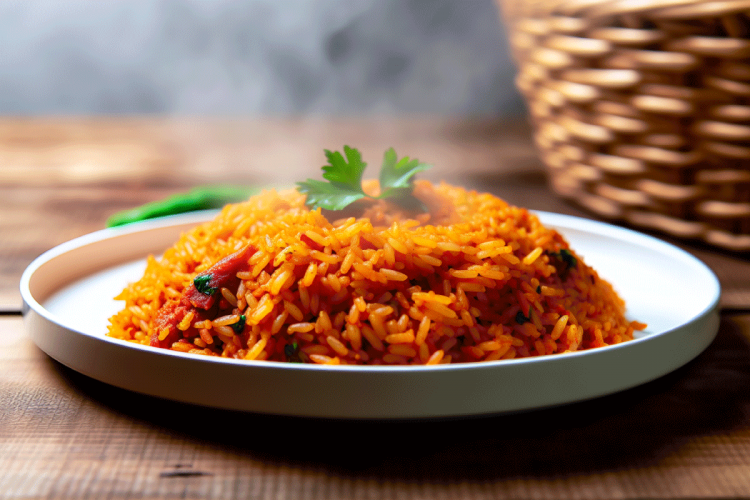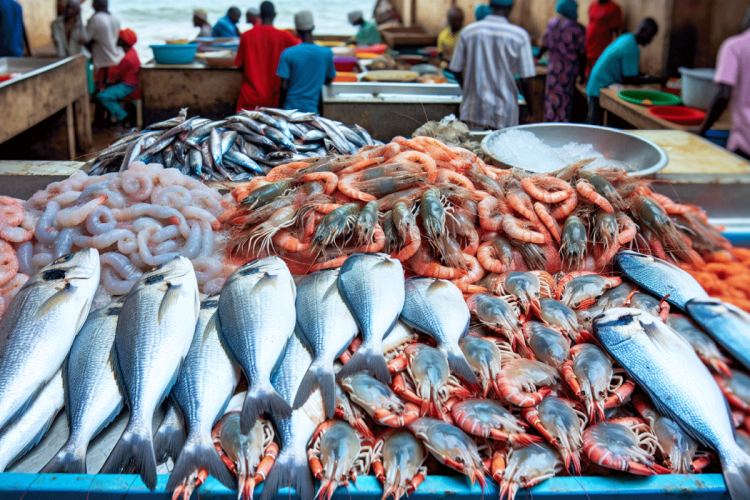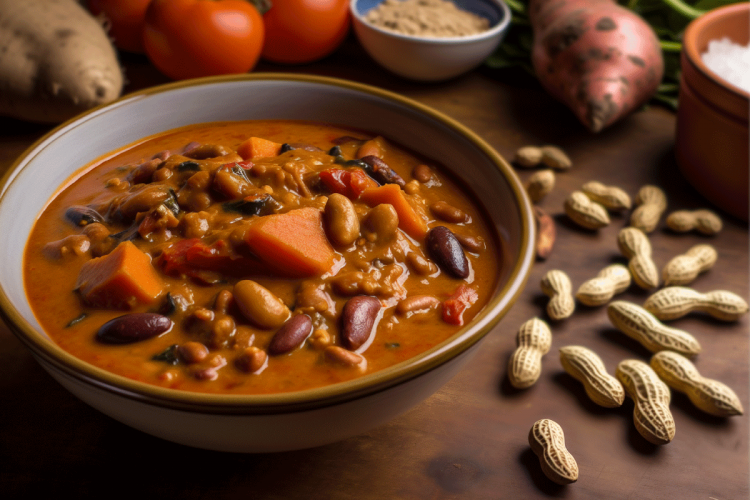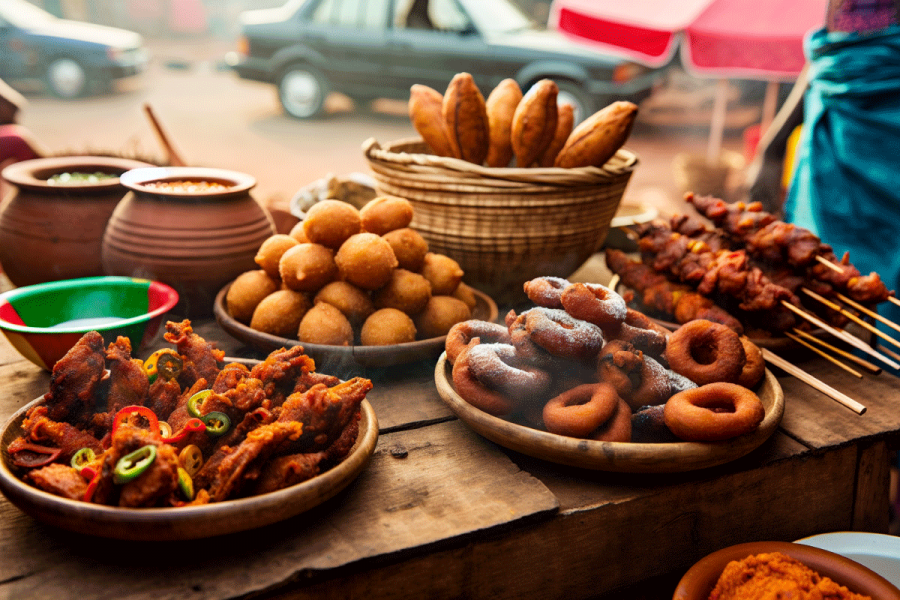A tour of traditional West African dish delights
Savor the spice
Embark on a culinary journey through West Africa as we explore distinctive local dishes that are as diverse as the region’s cultures. Discover what makes a West African dish stand out, from the staple grains and legumes to the fresh coastal seafood, all infused with an abundance of spices. Learn about the foods that not only bring comfort and nourishment but also celebrate the rich heritage of West African nations.
West African food
- West African cuisine is characterized by its rich use of starchy foods such as yams and cassava, nutrient-packed leafy greens, and versatile beans and peas, forming the foundation for many traditional dishes.
- Iconic West African foods like jollof rice, egusi soup, and groundnut stew showcase the diversity and cultural significance of the region’s cooking, with each dish offering a unique blend of flavors and textures.
- Spices play a crucial role in West African cooking, not only in enhancing the flavor of dishes but also in contributing to the health benefits of the cuisine, which utilizes slow cooking techniques and communal dining traditions.
Exploring the Staples of West African Cuisine
In the bustling markets and humble kitchens throughout West Africa, the melody of mashing yams and the cadence of chopping cassava play a rhythm that beats at the heart of this region’s culinary identity. The staples here are more than mere sustenance; they are the canvas on which a myriad of flavors are painted, each bite a testament to the nutrient-rich and versatile nature of indigenous foods like the Puna yam—dubbed the ‘king of crops’ for its dominance in local diets and economies.
From the thick, casserole-like yam stew of Burkina Faso to the fermented cassava pulp of Ivorian Attieke, each delicious dish is a chapter in the story of West African food.
The role of starchy foods
Fufu and gari, among other starchy staples, serve as much more than fillers in West African meals. They lay the groundwork for a multitude of dishes. They are the steady base that holds the vibrant symphony of flavors found in stews and soups like Nigeria’s asaro and Liberia’s Dumboy. Whether it’s the doughy paste of fufu scooping up a spicy stew or the granulated cassava of attieke balancing a fiery Egusi soup, these indigenous foods are essential to the region’s culinary quilt.
Leafy greens in West African cooking
The lushness of West African landscapes is mirrored in its generous use of leafy greens, which infuse dishes with both essential nutrients and bold, peppery flavors. Greens like Ugwu and Moringa elevate the nutritional profile of meals, while also adding a burst of color and taste that is unmistakably West African.
Leafy vegetables form an integral part of West African cuisine, whether they’re mixed into a hearty yam porridge or star in traditional dishes like the Gambian okra stew.
The versatility of beans and peas
Beans and peas in West African cooking are akin to culinary chameleons, adapting to form a wide array of dishes that span from the crispy Akara to the steamed bean pudding known as Moin Moin. These ingredients showcase the region’s flair for transforming simple elements into a delicious combination of flavors and textures that delight the taste buds.
The region’s rich and diverse culinary traditions are reflected in the versatility of beans and peas, including black eyed peas, which can be enjoyed both standalone or alongside other West African dishes.
A taste of West Africa and the signature dishes you can't miss
Venture deeper into the soul of West African cuisine and you’ll discover signature dishes that are the very essence of the region’s gastronomic prowess. Each nation boasts its own rendition of Jollof rice, a dish so revered it sparks friendly culinary rivalries. The rich tapestries of Egusi soup and the comforting embrace of groundnut stews are culinary treasures that have crossed borders, uniting West Africans in shared heritage and taste.
These are the dishes that define the region’s palate, each a flavorful dish that tells a story of its own.
Jollof rice: the celebrated one-pot wonder
Jollof rice is more than a dish; it’s a celebration on a plate. This one-pot wonder is a harmonious medley of:
- rice
- peppers
- tomatoes
- onions
- a blend of spices
that dance together to create a flavor that is truly West African.
Jollof rice, be it the smoky Ghanaian version simmered to perfection, or the Nigerian variety brimming with the warmth of native spices, is a national dish that takes center stage at every social gathering. This culinary masterpiece is an emblem of West African joy and unity.
Egusi soup: A rich melon seed delicacy
The rich and creamy Egusi soup is a testament to West African ingenuity, transforming melon seeds into a delicacy that is as nutritious as it is delicious. Paired with pounded yam or fufu, Egusi soup is a staple across Western and Central Africa, its nutty flavor and velvety texture a comforting reminder of home for many West Africans.
Every spoonful offers a glimpse into the culinary creativity of African cuisine, presenting a classic West African dish that serves as both a staple food and a gastronomic masterpiece.
The comfort of groundnut stews
The warmth of a West African kitchen is often aglow with the simmering of groundnut stew, a rich and hearty concoction that captures the essence of classic West African dishes. Known by many names – Maafe, Nkate Nkaway, or simply groundnut stew – this dish is a delicious tapestry woven from:
- peanuts
- tomatoes
- root vegetables
- a constellation of spices
These ingredients imbue the stew with a depth of flavor that is at once complex and comforting.
Its versatility allows it to be paired with a variety of starches, from rice to couscous, making it a ubiquitous delight throughout West Africa and Central Africa.
Sizzling street foods and snacks
The streets of West Africa are alive with the sizzle and pop of street food, a symphony of taste and texture that is an unmissable part of the region’s food culture. From the crispy crunch of Kelewele to the fluffy warmth of Puff-Puff, each street food is a story told through flavor. Suya, with its smoky aroma and spice-kissed meat, is the ultimate grilled meat skewer, a popular street food that is both a treat and a tradition.
These street snacks, savored by both West Africans and visitors, not only define the flavors of the streets but are also flavorful dishes in their own right.
Kelewele are spiced fried plantains
Kelewele, a beloved Ghanaian snack, is a celebration of simplicity and flavor. Ripe plantains, marinated in a blend of spices and fried to golden perfection, offer a delicious dish that balances the sweet with the spicy. This popular street food is a fixture at local markets and a favorite among those seeking a quick, flavorful bite.
Its charm lies in its simplicity, and its taste is a testament to the culinary magic that can be conjured with humble ingredients and traditional West African cooking techniques.
Puff-puff is Africa’s answer to doughnuts
Puff-Puff stands as Africa’s delicious answer to doughnuts, a deep-fried delight that tempts the taste buds with its crispy exterior and airy interior. This popular West African dish has crossed borders and won hearts, its simplicity and sweetness a universal language of indulgence.
Whether dusted with sugar or enjoyed plain, Puff-Puff is a street food staple that has secured its place in the pantheon of West African cuisines, a testament to the region’s love affair with fried dough.
Suya is the ultimate grilled meat skewer
The spice-infused, smoky taste of Suya is an experience not to be missed. Thinly sliced, marinated meat grilled over an open flame results in a delicious dish that encapsulates the essence of West African street food. From the bustling markets of Nigeria to the street corners of Ghana, Suya is a beloved snack, traditionally served with a side of fresh onions and a dusting of Yaji spice that leaves a lingering warmth on the palate.
It’s more than just food; it’s a cultural phenomenon, a taste of the African continent that brings people together.
Coastal flavors with fish and seafood in West African cooking
West Africa’s extensive coastline gifts its cuisine with an abundance of fresh fish and seafood, ingredients that are expertly transformed into dishes that are as delicious as they are nutritious. Here, the ocean’s bounty meets the creativity of West African cooking, resulting in a variety of succulent west african foods that are imbued with the flavors and traditions of the coastal regions. Some popular dishes include:
- Grilled fish with spicy marinade
- Jollof rice with shrimp
- Fish stew with vegetables
- Coconut rice with seafood
- Fried plantains with grilled shrimp
These dishes showcase the rich culinary heritage of West Africa’s coastal regions.
From grilled tilapia to stews enriched with smoked fish, the region’s coastal flavors are a testament to its rich culinary diversity and its people’s connection to the sea.
Grilled tilapia is a simple yet flavorful dish
Grilled tilapia is a testament to the adage that simplicity is the ultimate sophistication. This popular dish in West African cuisine is appreciated for its straightforward preparation that allows the natural flavors of the fish to shine through.
To make grilled tilapia, follow these steps:
- Brush the tilapia fillets with shea butter.
- Preheat the grill to medium-high heat.
- Place the tilapia fillets on the grill and cook for about 4-5 minutes on each side, or until the fish is opaque and flakes easily with a fork.
- Serve the grilled tilapia alongside Attieke or a fresh vegetable salad.
Grilled tilapia is a flavorful dish that embodies the coastal spirit of West Africa.
With every bite, this meal offers a comforting and nourishing taste of the sea.
Palm oil and smoked fish is a classic pairing
The duo of palm oil and smoked fish is a classic pairing in West African stews, their combined flavors forming the backbone of traditional cuisine. The rich taste of palm nuts in Banga soup and the savory depth of palm oil in fish stews are hallmarks of West African dishes that highlight the region’s love for bold and hearty flavors.
Showcasing the region’s culinary heritage and its love for rich, flavorful dishes, these stews are a delicious combination bursting with:
- tomatoes
- chili peppers
- garlic
- ginger
- a blend of spices.
Vegetarian delights in West African food
The vegetarian landscape of West African cuisine is as varied and vibrant as the region itself, offering an array of dishes that are not only meat-free but also full of flavor and nutrition. Some popular vegetarian dishes from West Africa include:
- West African Peanut Stew
- Vegan Yam and ‘Egg’
- Jollof Rice
- Akara (bean fritters)
- Moin Moin (steamed bean pudding)
- Egusi Soup (made with melon seeds)
- Okra Soup
These dishes are a celebration of the abundant produce and the culinary creativity of the people in the region.
These delicious dishes provide a plant-based bounty that caters to vegetarians and meat-lovers alike, proving that West African food can be both wholesome and delectable.
Okra Soup is a slimy but delicious dish
Okra Soup is a beloved vegetarian dish in West Africa, its unique slimy texture a hallmark of traditional cuisine. The careful addition of tofu and kale allows the dish to retain its distinct consistency while adding layers of flavor and nutrition.
This soup, emblematic of West African culinary ingenuity, provides a comforting and satisfying meal that explores a delightful variety of textures and tastes. By challenging preconceived notions of texture in food, it invites diners to experience the full spectrum of West African flavors.
Moin moin is the steamed bean pudding phenomenon
Moin Moin, the steamed bean pudding phenomenon, is a testament to the health-conscious and flavor-rich aspects of West African cuisine. This protein-packed vegetarian delicacy, traditionally wrapped in leaves and steamed to perfection, offers a savory taste that can be enjoyed at any meal, making it a great alternative to dishes like sweet potato in West African cuisine.
The versatility of Moin Moin is showcased through its various incarnations, from the addition of vegetables to the inclusion of plant-based proteins like tofu, making it a nutritious and delicious choice for anyone embracing the richness of West African food.
Regional specialties across West African nations
As one traverses the diverse landscapes of West Africa, the regional specialties encountered along the way are as varied as the cultures they come from. Each nation brings its own unique flavors and techniques to the table, creating an intricate mosaic of culinary expression.
From the corn and bean melody of Cape Verde’s Cachupa to Cameroon’s Ndole and Senegal’s Yassa chicken, the regional dishes of West Africa are a celebration of local ingredients and cultural narratives. These dishes represent more than just food; they serve as a culinary journey through the rich history and vibrant cultures of West African nations.
Senegal's national dish is thieboudienne
Thieboudienne, Senegal’s national dish, is a culinary icon steeped in the nation’s history and culture. This traditional dish, a hearty and flavorful combination of fish, rice, and tomato sauce, is not just a meal but a symbol of Senegalese pride. The dish’s versatility is such that it can be adapted to include chicken or meat, catering to a wide range of palates.
Thieboudienne is a delicious dish that brings together families and friends, embodying the spirit of communal dining that is central to West African cuisine.
Sierra Leone's cassava leaf stew
Sierra Leone’s Cassava Leaf Stew, known locally as saka saka or pondu, is a lush green tapestry of flavors that has earned its place as the national dish. This stew, rich with the earthy tones of cassava leaves and occasionally featuring sweet potato leaves, is a hearty soup that tells the story of the land’s fertility and the ingenuity of its people.
Packed with nutrients and protein, the stew is a delicious combination of traditional ingredients like beef, smoked fish, and peanut butter, slowly simmered to create a depth of flavor that is the essence of Sierra Leone’s culinary heritage.
Sweet treats and desserts of West Africa
The sweet side of West African cuisine is a delightful excursion into the world of desserts and treats. From the cool and creamy Dégué of Burkina Faso to the vegan-friendly Sombi of Senegal, the region offers an array of sweet treats that are as diverse as they are delicious. These desserts, in addition to satisfying the sweet tooth, display the region’s rich variety of tropical fruits and the creativity of its dessert artisans.
Whether it’s the fluffy Mandazi or the refreshing Bissap, the desserts of West Africa are a testament to the region’s ability to create sweets that are a joy to eat.
Chin chin is the crunchy cookie-like snack
Chin Chin, a traditional West African snack, crunches with the satisfaction of a well-made treat. This deep-fried delight, made with a simple dough and a sprinkle of aromatic spices like nutmeg, is often shared among friends and enjoyed at any time of day. Chin Chin’s crunchy texture and sweet flavor make it a popular street food and a beloved addition to any gathering.
It’s a snack that brings together the joy of homemade baking with the convenience of a grab-and-go treat, a delightful nibble that is characteristic of West African hospitality.
Bissap is the hibiscus tea tradition
Bissap, the hibiscus tea tradition of West Africa, is a refreshing beverage that captures the essence of the region’s love for vibrant, tart flavors. This popular drink, often sweetened and served chilled, is a staple in many West African countries, enjoyed for its thirst-quenching properties and its potential health benefits.
The deep red color and tangy taste of Bissap make it a favorite among locals and visitors alike, a traditional drink that is both a celebration of West African flora and a nourishing elixir.
The influence of spices in West African dishes
As the lifeblood of West African cuisine, the region’s spices infuse dishes with flavors as intense as the African sun. From the fiery heat of Habanero chili to the earthy warmth of ginger and the aromatic depth of Penja pepper, spices play a transformative role in West African cooking. They are the alchemists of the kitchen, turning simple ingredients into a feast for the senses.
Beyond their culinary uses, these spices are revered for their health benefits, making West African dishes not only delicious but also nutritious.
The heat of chilli peppers
Chilli peppers in West African cuisine are not just a source of heat; they are an invocation of passion and vitality. Integral to dishes like Jollof rice, these fiery morsels are revered for their ability to elevate the taste of a meal and for their cooling effect on the body.
The pungent piri piri pepper, revered across Africa, introduces significant heat and is believed to possess purifying qualities. Rich in vitamins and minerals, chilli peppers are a spicy stew of health-promoting attributes that West Africans have expertly woven into their culinary traditions.
Aromatic spices are more than just flavor
The aromatic spices of West Africa do more than just tantalize the taste buds; they are a treasure trove of health benefits. Capsaicin, the fiery heart of chili peppers, is not only an analgesic but also contributes to cardiometabolic health. Spices like Aridan and grains of paradise, steeped in traditional medicine, add layers of flavor while offering medicinal properties.
The role of spices in West African dishes is multifaceted – they are a celebration of the continent’s indigenous pharmacopeia and a testament to the culinary wisdom passed down through generations.
West African cooking techniques and traditions
West African cooking techniques and traditions represent a harmonious blend of time-honored practices and communal spirit, shaping the region’s dining culture. The practices of slow simmering stews in clay pots over a three-stone fire and fostering a convivial atmosphere during communal dining testify to the region’s rich culinary heritage.
The slow cooking technique is revered for its ability to coax out flavors and tenderize meats, while the act of sharing a meal reinforces the bonds of community and family. West African cooking is not just about the food; it’s about the shared experience of creating and enjoying a meal together.
Slow cooking is their secret to depth of flavor
Slow cooking in West African cuisine is the alchemy that transforms simple ingredients into dishes with a soulful depth of flavor. The gentle heat and prolonged cooking times allow flavors to develop complexity and meats to become fork-tender. Dishes like Kedjenou and Ogbono Soup are imbued with layers of taste that are only possible through the patience and care of slow cooked West African recipes.
This technique is a celebration of the region’s bountiful ingredients and a reflection of the cultural importance placed on taking the time to prepare and savor food.
Communal dining is a cultural experience
Communal dining in West Africa is a cultural experience that transcends the act of eating. It is a time-honored tradition that reinforces the values of sharing, respect, and community. Meals are often shared from a single bowl, with participants partaking from the portion directly in front of them, a practice that fosters unity and a sense of belonging.
The conclusion of a communal meal is marked by expressions of gratitude and blessings, a ritual that encapsulates the region’s spirit of hospitality and generosity. Communal dining in West Africa is not just about nourishing the body but also about nourishing the soul.
West African food
From the yam fields of the hinterlands to the bustling street markets, West African cuisine is a vibrant tapestry woven from the threads of tradition, community, and the rich bounty of the land and sea. The dishes we’ve explored are more than mere sustenance; they are cultural artifacts that tell the story of the people and the landscape from which they spring. Whether through the spicy heat of jollof rice, the comforting embrace of groundnut stew, or the shared pleasure of communal dining, West African cuisine invites us to explore a world of flavors that are as diverse as they are delightful, and go back to explore other food in Africa.
What is traditional West African food?
Traditional West African food includes tubers and starchy vegetables such as cassava, sweet potatoes, yams, and yucca, as well as peanuts, which traveled from South America with the Portuguese to West Africa. These ingredients are used to make dishes like Jollof Rice and Fufu, creating a diverse and flavorful cuisine.
What is a popular dish in Africa?
A popular dish in Africa is Fufu, which is a starchy staple made from cassava, yam or plantain and is popular in West and Central Africa (source: Answer 1). Jollof Rice is also widely enjoyed in many West African countries (source: Answer 1).
What food is from ancient West Africa?
Ancient West Africa is rich in traditional foods such as pearl millet, cowpea, African yam, fonio, cassava, cocoyams, sweet potatoes, plantains, and yams, some of which are still widely used today.
Is jollof a West African dish?
Yes, Jollof rice is indeed a popular West African dish enjoyed across the region.
What makes Jollof rice such a celebrated dish in West Africa?
Jollof rice is celebrated in West Africa for its rich, spicy flavor and its status as a national dish. Its versatility and ability to be adapted with different ingredients make it a staple at social gatherings and a symbol of cultural pride.

